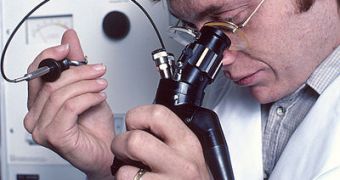Endoscopes are currently of tremendous use for doctors and patients alike, because they provide healthcare experts with the ability to look inside a body without having to resort to surgery, biopsies, or other types of invasive procedures. A University of Florida engineering researcher has now taken the utility of the endoscope to a new level, when he has designed a device capable of reaching even tighter and smaller spaces inside the human body, but not through direct observations.
Basically, the work of UF Associate Professor of Electrical and Computer Engineering Huikai Xie revolves around replacing the cameras used in current endoscopes with advanced scanners that are able to see beneath the surface of tissues, and into the root of the problem. This could take the entire imaging field to a totally new level, the scientist believes. Peculiar groups of cells and abnormal growth patterns, such as the ones that indicate a tumor, could also be detected at first glance, allowing for a faster detection of emerging conditions, including cancer.
“Right now, endoscopes just take pictures of the surface tissue. So, if you see some injury, or abnormality, on the surface, that's good. But most of the time, particularly with cancer, the early stages of disease are not so obvious. The technology we are developing is basically to see under the surface, under the epithelial layer,” Xie explains. He admits that the devices he and his colleagues have developed have not yet been tested on humans, but he adds that the early results the group obtained in animal testing are very promising and worth pursuing.
Further improvements can be brought to this technology, the expert says, including adding cutting tools to the micro-endoscopes. “We are trying to couple this imaging probe with cutting tools, so that when surgeons begin cutting, they know exactly what's in front of them,” Xie explains. “The impact on quality of care could be huge, allowing more comprehensive screening than is possible with point biopsies, and making it possible to achieve both diagnosis and treatment in a single patient visit,” Montana State University Professor of Electrical and Computer Engineering David Dickensheets shares.
“Professor Xie's research is at the leading edge of this emerging technology area, and he has worked hard to move the technology out of the laboratory and into demonstration instruments that show its potential,” he adds.

 14 DAY TRIAL //
14 DAY TRIAL //